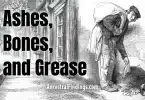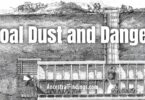Of all the jobs people avoided, feared, or whispered about, the gravedigger stood near the top of the list. Working in quiet corners of churchyards, behind iron fences, or in the shadows of city cemeteries, the gravedigger did work no one else wanted—making room for the dead and handling what came after.
But for centuries, this job was a critical part of every community. It wasn’t glamorous, and it certainly wasn’t clean, but the people who did it kept burial grounds in order, protected public health, and honored the basic dignity of the dead.
In this final part of our series on dirty jobs, we’re going beneath the surface—literally—to explore the long, hard, and sometimes heartbreaking path of the gravedigger.
The Work No One Talked About
Gravedigging wasn’t just about shovels and dirt. The job came with all kinds of responsibilities. Some gravediggers dug plots by hand—sometimes multiple graves in a day, especially during disease outbreaks. Others maintained cemetery grounds, repaired fences, kept records, and even assisted with funerals.
In small towns, the gravedigger was often also the town sexton—a caretaker for the entire burial ground. In larger cities, especially by the 1800s, gravediggers were often day laborers hired by the cemetery. During epidemics, churches and city governments paid men to dig dozens of graves a week, often in haste.
There was no backhoe, no machinery in the early days. Just a pick, a shovel, and a lot of sweat. Graves had to be dug deep—six feet, traditionally—though that varied depending on location, climate, and custom. Cold, frozen ground in the winter made this job all the harder.
And it was dangerous. Collapsing soil, hidden roots, exposure to disease, and injuries from hand tools were all real risks. In some places, digging graves for victims of cholera, typhus, or yellow fever came with the added fear of catching the illness yourself.
But despite all of this, the gravedigger had a strange kind of trust. Families often knew who buried their loved ones. Sometimes, that trust was passed down—father to son, or kept in the same family for generations.
Historical Roots: A Job as Old as Burial Itself
The need for gravediggers goes back thousands of years. Every society that practiced burial had someone responsible for preparing the ground. In ancient Rome, there were slaves and low-status workers assigned to handle the dead. In medieval Europe, gravediggers were often attached to churches and monasteries.
By the 17th and 18th centuries in colonial America, the local church or town would often appoint a man to be both the gravedigger and the bell-ringer—a common pairing. He may have also been the one to toll the bell announcing a death, then dig the grave, then maintain the grounds afterward.
In the 19th century, particularly in larger cities, the role expanded. Cemeteries became businesses. As public health laws improved, so did cemetery planning. Larger burial grounds needed more staff—men to dig, maintain lawns, open mausoleums, and monitor grave robbing, which was a real issue in some areas due to medical schools seeking cadavers.
And yes, the work sometimes came with stories of ghost sightings, strange noises, and superstitions. Many gravediggers ignored them. Others leaned into the mystery, especially if it helped keep thieves—or nosy visitors—away.
A Day in the Life
What did a typical day look like?
It depended on the century, of course. In 1700s New England, the town sexton might rise early, walk to the meeting house, and check the burial ground for signs of damage—fallen stones, animals digging, weather erosion. If there was a death in town, he’d measure out the grave, dig it by hand, and sometimes even help carry the coffin.
By the 1800s in cities, cemetery workers had more defined shifts. Some focused on digging, others on mowing, some on transporting bodies within the grounds. There were even nighttime patrols to stop grave robbers.
The work was physical. Muddy in the spring. Backbreaking in the summer. Freezing in the winter. But it was stable, and often respected—if quietly.
Ulysses S. Grant: A President and a Grave-Digging Connection
While there’s no evidence that Grant himself worked as a gravedigger, he is buried today in one of the most famous tombs in the world—Grant’s Tomb in New York City. The planning, construction, and maintenance of such a site included a workforce of cemetery workers and diggers.
Other figures, however, did work with the dead. Abraham Lincoln, before becoming president, was known to help his father build coffins in his youth. Folk traditions also tell of Civil War soldiers being assigned burial duty after battles—digging mass graves for their fallen comrades. The line between soldier and gravedigger often blurred.
Finding a Gravedigger in Your Family Tree
If one of your ancestors held this profession, the records may not be obvious—but they’re out there.
Start with census records. Look for occupations listed as “sexton,” “cemetery worker,” “laborer at cemetery,” or even “church caretaker.” In smaller communities, gravediggers often had multiple roles, so you might see “sexton and bell ringer,” or “caretaker and grave digger.”
Church records are key. Parish burial logs sometimes included the name of the person who prepared the grave. Meeting minutes may have notes about payments to the gravedigger or complaints about cemetery upkeep.
City directories from the late 1800s through the early 1900s often list cemetery staff by title.
Don’t forget newspapers. Notices of burial often included who managed the graves. In larger towns, cemetery associations kept detailed payroll records. If those survived, they can tell you a lot.
Also, death records sometimes list occupation—even if the person was a cemetery worker. And if your ancestor lived near a burial ground, land records might mention their involvement.
The Role in Times of Crisis
During epidemics, wars, or natural disasters, gravediggers were some of the busiest people in town. Their stories may not have been recorded in full, but their actions mattered.
In the 1918 influenza pandemic, entire cemeteries struggled to keep up. In some places, prisoners were conscripted to dig graves. But elsewhere, the regular cemetery staff—many of whom worked without proper protective gear—dug hundreds of graves in silence.
There are recorded moments of kindness, too—gravediggers placing flowers, smoothing dirt, or saying a prayer after families left. They were the last to leave, the final caretakers of a person’s journey.
An Occupation Remembered
Gravediggers rarely left memoirs. But their legacy is written in the land itself. In the shape of old churchyards. In the way tombstones are arranged. In the quiet maintenance of sacred places.
If your ancestor did this work, they deserve to be remembered. They saw grief up close and still did the job. They kept the wheel of community turning—quietly, steadily, and sometimes heroically.
They may not have worn a uniform or held office. But they did something most people wouldn’t dare. And that makes them worth honoring.
So as we close out our series Tracing Dirty Jobs of the Past, take a moment to remember the hands that built the resting places of our ancestors. Behind every grave is someone who made sure it was there.
They didn’t just dig dirt. They carved out space for memory.
And that’s a job worth tracing.




